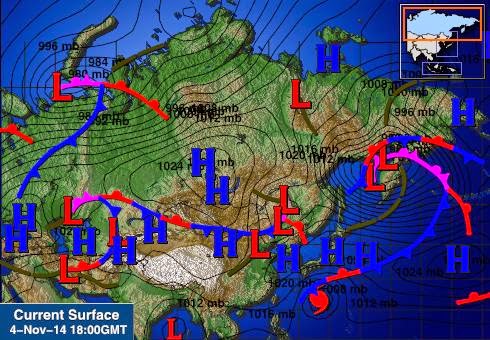Monsoon System has increased over more areas and surfaces in the 21 century, but the monsoon system has decreased in circulations. Overall there is medium confidence that says precipitation will increase in Asian-Australian monsoon(Christensen 1219). Indian Ocean is probably show a zonal pattern of change later on when water is colder and precipitation less in the east, and water is warmer and precipitation more in the west.(Christensen 1219). Most likely the world frequency of tropical cyclones can decrease or remain the same, but the tropical cyclone wind speed and precipitation rates will increase more (Christensen 1220). The Northern and Southern Hemispheres will not increase on blocking. The trends is what is blocking intensity and remain uncertain (Christensen 1220).
My country Japan, is located in Asia, apparently Asia is likely to have number of colds day and nights decrease over and time and the number of warm days and nights to increase.(Hijioka 1333-1334) The East Asian and Winter Monsoon circulation have been getting weaker and weaker through out the years(Hijioka 1333-1334). Since the 1920s the East Asian summer monsoon started to weaken in the sea level gradient(Hijioka 1333-1334). The ratio of rainfall for the wet to dry seasons have increased between 1955 to 2005 in Southeast Asia(Hijioka 1333-1334). In the East, South, and Southeast Asia, it is more likely in the future that the precipitation related to the monsoon are going to increase(Hijioka 1333-1334). The subtropical and topical oceans will warm and the warming signals will show(Hijioka 1333-1334). In 1960's, China area have been having weaker seasonal and annual mean winds (Hijioka 1333-1334.) These section is telling us, how the climate is change globally. Asia's season and weather is getting mess up because of these climate change. The seasonal Asian Monsoon, which is a famous phenomenon, is getting weaker but is spreading. Just these small factors are changing around the world.
The Phenology and growth rates are a huge impact that sounds interesting to me. The East Asia 's plants are measured by the "greenness"(Hijioka 1339). Since 1980s, the season spring has been having early leafing days(Hijioka 1339). The spring flowering early and fall senescence falling behind has been written down (Hijioka 1339). This showing the that the season days have got all messed up, and maybe in the future summer days will have fall/autumn events happen instead. The spring growth have gone ahead in the 90s but the trend is different between areas and the data (Yu et al., 2010, 2012; Dong et al., 2013; Jin et al., 2013; Shen et al., 2013; Yu, Z. et al., 2013a; Zhang, G. et al., 2013; Zhang, L. et al., 2013). Getting closing to the spring greening and longer growing season are known to have humid temperate and boreal areas (Hijoka 1340). I chose this impact because the seasons and the growth rates tell us how the climate changing slowly around us. It doesn't destroy any wildlife or plants, but it can affect people later on in the future because the season are slowly getting more earlier and earlier. Do I care about the economics? Of course I do. There is nothing dangerous about this impact but maybe later on, it could be a risk. The animals and nature are affect by this impact because it decides the seasons greening and growth rates.
 |
| http://static.guim.co.uk/sys-images/Environment/Pix/columnists/2010/10/21/1287657605700/Climate-Change-Vulnerabil-008.jpg |
 |
| http://scienceofdoom.files.wordpress.com/2010/01/ipcc-2007-temperature-150yrs.png |
 |
| https://c1.staticflickr.com/3/2634/3719017725_8c14405266.jpg |
.jpg)







